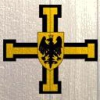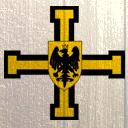 Нажмите, чтобы прочитать
Нажмите, чтобы прочитать More XVII Century Polish Military, Political, and Cultural Background
©2001 Richard J. Orli
Home -Main Menu
Adam Zamoyski 's Military Overview
The Swedish Connection
Crown Army in 1683 (Excluding Lithuanian Units)
Look for several topics here, later.
Adam Zamoyski 's Military Overview
Adam Zamoyski in his excellent ‘The Polish Way’ (1987 Hippocrene Books, NY, NY) gave a succinct description of Polish Military tactics. (His entire words on the subject are below, since several ‘Polish-history web sites’ use his words without attribution.)
"The Father of Polish military science was Hetman Jan Tarnowski, who published his Consilium Rationis Bellicae in 1558. He elaborated the old Hussite tactic of forming a gigantic square, a mobile fortress which could save a small army caught out in the open field, and this became standard practice in all operations against Tatars and Turks. Tarnowski also developed the traditional features of Polish strategy, most of which were unique. The high degree of mobility and the need to live off the land were both reasons for Polish armies operating in divisions, while most European armies marched in a great mass until the end of the eighteenth century. Another peculiar feature was the tradition of the deep cavalry raid sweeping out ahead of the main army, sometimes covering over a thousand miles in a great arc behind enemy lines. The crux of any battle was the cavalry charge. This was not the same as the heavy massed armoured attack which had come to grief on the battlefields of the Hundred Years' War in France. It was an elaborate manoeuvre of probing charges by light cavalry supported by artillery leading up to the decisive charge by heavy cavalry deployed in a chequerboard pattern and not a single mass. Each troop had space on all sides, so the bringing down of one rank or section did not affect the others."
Zamoyski describes artillery:
"The Poles set great store by artillery, and in this they were in advance of their enemies until the eighteenth century. They preferred lighter cannon to heavy pieces, purposeful direction to saturation bombardment and mobility to numbers. At Kircholm in 1610, Chodkiewicz defeated the Swedes with only four cannon, at Klushino in 1610 Zolkiewski had only two. From the Turks the Poles learnt much about incendiary and explosive shells, and they themselves developed rocketry to great effect. They had a number of good theoreticians, most notably Kazimierz Siemienowicz, whose influential treatise on multi-stage rocketry was published in 1650; and outstanding commanders, such as Marcin Kantski, who alone of all the allied generals managed to bring his guns to bear at the relief of Vienna in 1683."
Infantry:
"Similar principles obtained in the infantry. Lightly dressed, without helmets or armour, the soldiers were armed with a musket, short sword and hatchet. Only one man in eight carried a pike. In the 1550s, a Polish regiment of 200 men could deliver 150 shots in five minutes, while contemporary Spanish brigades of 10,000 men operating in the Netherlands could only deliver 750 in the same time. Polish infantry possessed ten times greater fire-power on a man-to-man basis than standard European infantries."
Hussars:
"The pride and glory of the Polish cavalry, its mailed fist, was the Husaria, the winged cavalry. This operated in regiments of about three hundred men highly skilled and armed to the teeth. The companions of the front rank carried an astonishing lance of up to twenty feet in length, which outreached infantry pikes, allowing the Husaria to cut straight through a square."
-----------------------------
Zamoyski further elaborated on equipment and organization. The material below is based on Zamoyski's but primarily Brzezinski's work.
The Hussar’s secondary weapons included the koncerz, a straight rapier-like weapon with a 60-70 inch long blade which doubled as a pike – used from horseback only. Each companion also carried a sabre; a pair of pistols (mandatory since the 1570s under an edict of King Stephan Bathory); a short carbine and/or a bow and arrows; a czekan, a long steel hammer, and presumably a knife and a whip as well.
Polish units were organized either in the traditional model – narodnie autorament and foreign model – niemiski autorament. The largest contingent was on the traditional model.
Infantry were usually commoner volunteers or sometimes levies called ‘quarter troops’ since they were paid from a 25 percent tax on revenue from Crown and starosity (county) lands. A special type of peasant unit was the Piechota Wybraniecka, ‘Select Foot’, who were retained on reserve against revenue on Royal Lands. These received regular training, and proved to be effective units with high morale.
The cavalry was almost entirely composed of szlatchta (gentry) and was organized into Banners (choragiew pronounced hor-en-g’ev, or also known as rota) in a semi-feudal system. The front rank troops were the equivalent of the knights, called towarazysze, ‘comrades’ or ‘companions’ – men with skill, rank, and some wealth. Each comrade would bring his pocztowi, ‘retainers’, as many as he could afford to equip, from 50 to 1. The Comrade and his retainers constituted a Post (poczet). These retainers were almost always szlatchta, although most were poor. In the Hussar units, only the front rank comrades used the 20-foot lance. The unit was entirely financed by the comrades, although they received pay when on active duty.
Each Banner (or Troop) of 60 to 300 men was led by a Rotamistrz, an officer with a commission to raise a Banner. He appointed a lieutenant (Poruznik), ensign, and other staff. Several Banners combine into a Pluk, similar to a regiment, although rather larger than a western regiment.
Foreign model troops were initially mercenary, but became mostly Polish-staffed.
The Swedish Connection
The Swedes were generally enemies of the Poles and of most decent folks in the Balkens area - they had a sort of a bad boy reputation. The elected Polish King Zygmunt III Vasa was brother of the Swedish King, and on his brother's death took the Swedish crown as well. Unfortunately, he was a rabid catholic, and the Swedes were Lutheran, and various factions rallied around Carl to depose the King in 1599. Zygmunt III did not take this lightly, and this helped touch off a war, and was a recurring theme in a series of wars that did not end until the 1660.
Zygmunt III Vasa ruled from 1587-1632. The first war with Sweden was largely successful for Poland. Hostilities resumed in the 1620s, under King Gustav Adolf. Although Poland won the field battles and even a navel battle, Sweden managed to capture Riga and control most of Livonia; also, ducal Prussia won some independence from Poland. At the urging of the French and Cardinal Richlieu, and with other treats from Turkey, Russia, and their Tatars, Poland made peace, freeing Sweden to engage in the 30 Years War.
Wladeslaw IV Vasa ruled from1632-1648. A dashing and skillful solider, he won a war against the Russians, took Moscow, and placed a Polish candidate on the Russian throne.
The Ukrainian Cossacks rebelled against Polish rule in 1647, and were defeated by Wladeslaw IV.
They revolted again under the reign of Jan Kasmier, Vasa, 1648 1668, and were joined in the way by the Russians. The Cossacks caught the Polish army in a bad situation and destroyed it. At the same time in Poland the political situation had disintegrated into anarchy. Sweden under Charles X joined forces with the dissidents and launched an invasion that was virtually unopposed. Almost all of Poland was occupied - an event called the Deluge (Potop). This, plus the bad behavior of the Swedish army, caused a patriotic revival, and a Polish force defeated the Swedes in the south, and soon drove them out of Poland altogether. A war between Sweden and Denmark proved useful to the poles, who joined the Danes in driving the Swedes out of Denmark as well. However, much land had been lost to Russia, the Turks, and Prussia.
Crown Army in 1683 (Excluding Lithuanian Units)
The Polish Army was composed of several unit types, and the annual maintenance expense of each is revealing . These totals cover all troops, and much of the infantry and some of the cavalry was assigned to border and town security, and would not participate with a field army.
Unit Type Maintenance Cost, in Zloty
Hussar - Heavy Cavalry 492,966
Arqbusers (Mounted Carabiners, or western-model troops) 72,531
Panzer - Medium Cavalry 1,099,812
Light Cavalry 217,308
Western-style infantry 1,530,144
Polish/Hungarian-style infantry 55,152
Dragoons 591,932
Artillery 256,390
Artillery was funded as follows in 1683:
Quarter tax 106390
Voted funds, senate 50000
Papal Subsidy 100000
Artillery was few in numbers and of uneven quality until Vladislav Vasa instituted a new Quarter tax in 1632. The new tax was used entirely to modernize the Artillery and Sappers.
Batteries in the Crown Army, 1683, and Horses assigned to each piece
Gun Type Batteries Horses Per Gun
24 Pdr 6 24
12 Pdr 12 12
6 Pdr, Long 8 15
6 Pdr, Short 12 4
3 and 2 pdrs 12 3
There were also several big siege guns in the inventory. The number of guns in each battery seemed to vary depending on caliber, with more guns in the smaller caliber. I do not have figures, but, 4 to 6 two pounders in a battery seems likely. Only 28 guns, all smaller than 6 pounders, participated in the Battle of Vienna..
 Нажмите, чтобы прочитать
Нажмите, чтобы прочитать



 Тема закрыта
Тема закрыта









